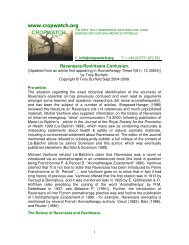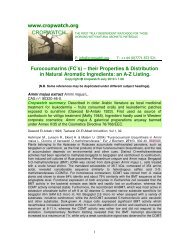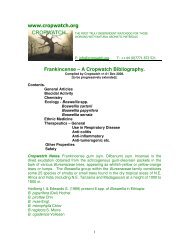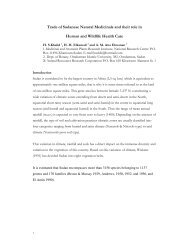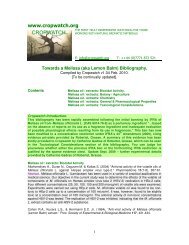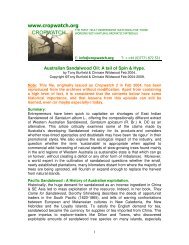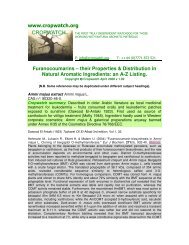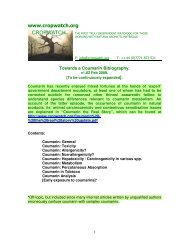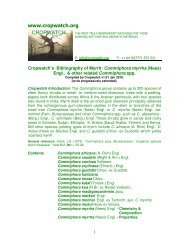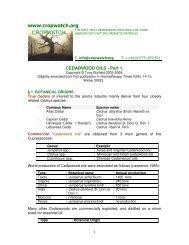Sandalwood Biblio - Cropwatch
Sandalwood Biblio - Cropwatch
Sandalwood Biblio - Cropwatch
Create successful ePaper yourself
Turn your PDF publications into a flip-book with our unique Google optimized e-Paper software.
changes." Phytochemistry 58(2), 203-12. Abstract. An early development-specific soluble 55 kDa<br />
Ca(2+)-dependent protein kinase has been purified to homogeneity from sandalwood somatic<br />
embryos and biochemically characterized. The purified enzyme, swCDPK, resolved into a single<br />
band on 10% polyacrylamide gels, both under denaturing and non-denaturing conditions.<br />
swCDPK activity was strictly dependent on Ca(2+), K(0.5) (apparent binding constant) for Ca(2+)-<br />
activation of substrate phosphorylation activity being 0.7 microM and for autophosphorylation<br />
activity approximately 50 nM. Ca(2+)-dependence for activation, CaM-independence, inhibition by<br />
CaM-antagonist (IC(50) for W7=6 microM, for W5=46 microM) and cross-reaction with polyclonal<br />
antibodies directed against the CaM-like domain of soybean CDPK, confirmed the presence of an<br />
endogenous CaM-like domain in the purified enzyme. Kinetic studies revealed a K(m) value of 1.3<br />
mg/ml for histone III-S and a V(max) value of 0.1 nmol min(-1) mg(-1). The enzyme exhibited high<br />
specificity for ATP with a K(m) value of 10 nM. Titration with calcium resulted in the enhancement<br />
of intrinsic emission fluorescence of swCDPK and a shift in the lambda(max) emission from<br />
tryptophan residues. A reduction in the efficiency of non-radiative energy transfer from tyrosine to<br />
tryptophan residues was also observed. These are taken as evidence for the occurrence of<br />
Ca(2+)-induced conformational change in swCDPK. The emission spectral properties of swCDPK<br />
in conjunction with Ca(2+) levels required for autophosphorylation and substrate phosphorylation<br />
help understand mode of Ca(2+) activation of this enzyme.<br />
Anil V.S., Harmon A.C. & Rao K.S. (2003) "Temporal association of Ca(2+)-dependent protein<br />
kinase with oil bodies during seed development in Santalum album L.: its biochemical<br />
characterization and significance." Plant Cell Physiol. 44(4),367-76. Abstract. Calcium-dependent<br />
protein kinase (CDPK) is expressed in sandalwood (Santalum album L.) seeds under<br />
developmental regulation, and it is localized with spherical storage organelles in the endosperm<br />
[Anil et al. (2000) Plant Physiol. 122: 1035]. This study identifies these storage organelles as oil<br />
bodies. A 55 kDa protein associated with isolated oil bodies, showed Ca(2+)-dependent<br />
autophosphorylation and also cross-reacted with anti-soybean CDPK. The CDPK activity<br />
detected in the oil body-protein fraction was calmodulin-independent and sensitive to W7 (N-(6-<br />
aminohexyl)-5-chloro-1-naphthalene sulfonamide) inhibition. Differences in Michaelis Menton<br />
kinetics, rate of histone phosphorylation and sensitivity to W7 inhibition between a soluble CDPK<br />
from embryos and the oil body-associated CDPK of endosperm suggest that these are tissuespecific<br />
isozymes. The association of CDPK with oil bodies of endosperm was found to show a<br />
temporal pattern during seed development. CDPK protein and activity, and the in vivo<br />
phosphorylation of Ser and Thr residues were detected strongly in the oil bodies of endosperm<br />
from maturing seed. Since oil body formation occurs during seed maturation, the observations<br />
indicate that CDPK and Ca(2+) may have a regulatory role during oil accumulation/oil body<br />
biogenesis. The detection of CDPK-protein and activity in oil bodies of groundnut, sesame,<br />
cotton, sunflower, soybean and safflower suggests the ubiquity of the association of CDPKs with<br />
oil bodies.<br />
Anon (1999) “Tree farming: More on sandalwood cultivation: Economics of sandalwood<br />
plantations.” Agric. & Industry Survey, Mar/April pp30-32.<br />
Anon (1997) “<strong>Sandalwood</strong> oil crop suffers burn.” HerbalGram 41, 54.<br />
Anon (2004) “Squads to check <strong>Sandalwood</strong> smuggling” The Hindu 14.05.04 at:<br />
www.hinduonnet.com/thehindu/2002/05/ 14/stories/2002051403200400.htm<br />
Anon (2007) "Company News: Karnataka Soaps launches turmeric soap in Andhra." Focus on<br />
Surfacants 12 (Dec 2007), p7. Quote: “Karnataka Soaps also plans to increase its production of<br />
sandalwood soaps from 7200 tonnes in 2005-2006 to 8000 tonnes in 2007-2008.”<br />
Anon (2009) "Forest Dept to promote sandalwood cultivation." The Hindu 17th July 2009.<br />
Synopsis: Karnataka forest department has decided to promote sandalwood cultivation in the<br />
district by distributing around 50,000 seedlings this year....<br />
40





